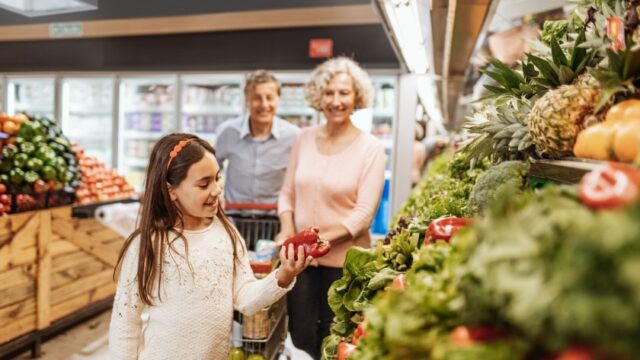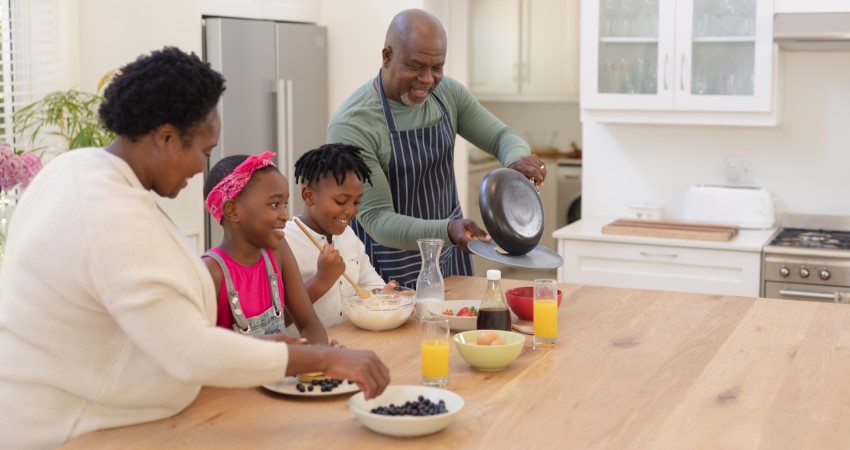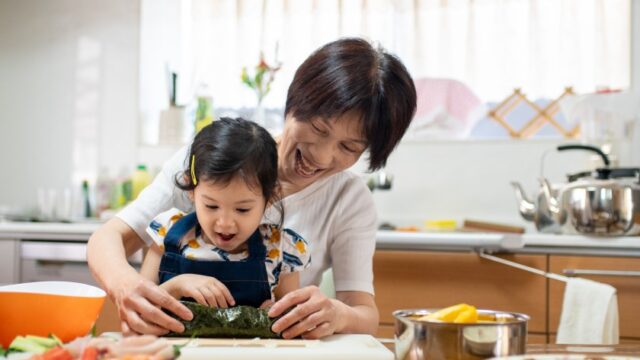Fact Sheet
Supplemental Nutrition Assistance Program (SNAP) for Kinship/ Grandfamilies
Download This Resource

Background Information
The Supplemental Nutrition Assistance Program (SNAP), previously known as food stamps, is the nation’s largest nutrition program. By providing monthly benefits to purchase food, SNAP plays a critical role in reducing hunger, malnutrition, and poverty, and improving family security, child and adult health, employment, and other outcomes. Each month, tens of millions of people benefit from SNAP.
SNAP can provide support in times of need, such as after the loss of a job or a reduction in work hours. It can be especially helpful when there is an unexpected arrival of a grandchild or other child to the household.
SNAP (which may be called something else, depending on the jurisdiction) is administered by the United States Department of Agriculture (USDA) and by the SNAP agency in the state or territory. SNAP operates in all fifty states, the District of Columbia, and two territories: Guam and the U.S. Virgin Islands.
Currently, tribal governments do not have the right to administer SNAP. State agencies are required to consult with Indian Tribal Organizationsabout the implementation and operation of SNAP on reservations. People who live on tribal lands should apply through the SNAP agency in the relevant state.
Nutrition Assistance Program Benefits in Puerto Rico, American Samoa, and the Commonwealth of the Northern Mariana Islands
Instead of SNAP, Puerto Rico, American Samoa, and the Commonwealth of the Northern Mariana Islands operate the Nutrition Assistance Program (NAP). Unlike SNAP, NAP operates based on fixed annual Congressional funding (a block grant), meaning that participation is capped. Puerto Rico, American Samoa, and the Commonwealth of the Northern Mariana Islands establish the eligibility and benefit levels for their NAP programs. To learn more about NAP, see this information from USDA.

Frequently Asked Questions for Grandfamilies and Kinship Families
What is SNAP?
SNAP, formerly known as food stamps, is widely considered the nation’s first line of defense against hunger. It enhances the purchasing power of millions of households with low incomes. SNAP is vital to participants’ nutrition, health, and well-being.
How does SNAP help?
SNAP provides grandfamilies and kinship families with critical support for stretching limited food budgets and helping put food on the table. SNAP benefits are loaded onto an Electronic Benefits Transfer (EBT) card – which works like a debit card – so that households can purchase food at participating supermarkets, farmers’ markets, and other food stores.
SNAP can be used to buy most types of food. SNAP can also be used to buy seeds for growing food.
SNAP cannot be used for:
- Hot ready-to-eat foods, such as pizza or rotisserie chicken
- Beer, wine, liquor, cigarettes, or tobacco
- Non-food items, such as paper products, personal hygiene items, and diapers
- Vitamins, medicines, and supplements
- Pet food
TIP: When there is a natural disaster like a fire, hurricane, or tornado, Disaster SNAP has special rules that provide temporary food benefits to households that have been affected.

Who can apply?
SNAP is available to eligible households with low incomes in every state, the District of Columbia, Guam, and the U.S. Virgin Islands, and on tribal lands.
This fact sheet focuses on grandfamilies and kinship families, who are families in which grandparents, other relatives, or close family friends are raising children because their parents cannot. The terms can be used interchangeably with one another or in combination, as in kinship/grandfamilies.
There are no caps or waitlists for SNAP participation, so all eligible grandfamilies and kinship families can apply for and participate in SNAP. Many people who work full- or part-time with low wages, receive Social Security, or have a small pension are eligible for SNAP.
If all members of a household are receiving Temporary Assistance for Needy Families (TANF), Supplemental Security Income (SSI), or, in some places, other general assistance, that household may be deemed “categorically eligible” (automatically eligible) for SNAP since the household has already been determined eligible for another means-tested program. This automatic eligibility for SNAP does not extend to households that receive Social Security Disability Insurance (SSDI).
This SNAP Eligibility Calculator can give you a sense of whether you are eligible for SNAP and what your benefit level might be. However, you won’t know for sure until you apply, and the SNAP agency determines whether you are eligible and how much your household will receive.
TIP: There are special SNAP rules for determining household income if the household includes an older adult (age 60+) or a person with a disability, including allowing the deduction of out-of-pocket medical expenses. These rules can expand program access to more grandfamilies and kinship families.
How much does a household get?
SNAP benefits vary depending on the household’s circumstances. The amount of money you get on your EBT card is primarily determined based on your household’s income and size. As of October 1, 2022, a household of two people is eligible for benefits ranging from $23 to $516 per month. The SNAP levels are adjusted each year beginning on October 1st.
A “household” for SNAP purposes includes all people who live and “purchase and prepare” meals together. This means people do not need to be related or have a formal, legal relationship to be a SNAP household.
SNAP Maximum Monthly Allotment for Selected Household Sizes for Fiscal Year 2023 (October 1, 2022 to September 30, 2023)
| Number of People in Household | Maximum Monthly Allotment |
|---|---|
| 1 | $281 |
| 2 | $516 |
| 3 | $740 |
During the COVID-19 Public Health Emergency, federal action has temporarily increased SNAP benefits through Emergency Allotments (EAs). While some states, Guam, and the U.S. Virgin Islands no longer issue SNAP EAs, many states and the District of Columbia continue to do so as of fall 2022. Once the U.S. Department of Health and Human Services (HHS) COVID-19 Public Health Emergency Declaration (PHE) expires, SNAP EAs will end everywhere. The PHE is not expected to end before January 2023, with HHS committed to providing a 60-day notice period before ending it.
Can a household participate in SNAP and other nutrition programs at the same time?
You and your family can participate in SNAP and other food programs, including the Special Supplemental Nutrition Program for Women, Infants, and Children (WIC); school meals; senior meals; home-delivered meals; and the Commodity Supplemental Food Program (CSFP) at the same time. You can also receive food from food banks or pantries at the same time. However, you cannot participate in SNAP and the Food Distribution Program on Indian Reservations (FDPIR) at the same time.

How can a household apply for SNAP?
You must apply for SNAP in the state or territory where you live. People who live on tribal lands should apply through the SNAP agency in the relevant state.
- Find your SNAP agency: USDA’s SNAP State Directory of Resources
- Learn more about eligibility and access additional information: USDA’s SNAP Eligibility and Frequently Asked Questions.
While there are federal SNAP program requirements that all SNAP agencies must follow, states can adopt different rules that may make it easier to apply without having to go into a SNAP office.
Facts for Grandfamilies and Kinship Families
- SNAP can help you put food on the table. Raising a child is expensive, especially when you may not have been expecting to have a grandchild or other kin in your care. SNAP allows you to shop for the food that’s right for you at participating grocery stores, farmers’ markets, corner stores, and other food retailers.
- The amount of SNAP benefits you get can be substantial. SNAP benefits are targeted to households with low incomes and the amount is largely based on how low your income is and how many people are in the household. Starting October 1, 2022, a household of two could receive a maximum of $516 per month, and the minimum benefit for a two-person household is $23 per month. Most grandfamilies and kinship families receive much more in SNAP than the minimum benefit. And even the minimum benefit adds up to $276 per year.
- You do NOT need legal custody or guardianship of the child you’re raising to apply for SNAP. SNAP is given to households who live, purchase, and prepare meals together, regardless of whether they have a legal relationship. You just need to list the child or children living with you when you apply. NOTE: If the child or children living with you were already receiving SNAP benefits before they came to live with you, they still may be eligible to receive benefits with you, depending on your income and resources. It’s important that you or the child’s parent (or other adult who was part of the previous SNAP household) let the SNAP agency know that the child is now living with you.
- You do NOT need to be related to the child you’re raising to apply for SNAP. For SNAP, a household is made up of the people who live, purchase, and prepare meals together, regardless of their relationship to each other. You just need to list the child or children living with you when you apply. (Please see the note on fact 3 if the child you are raising was already receiving SNAP before coming to live with you.)
- Participating in SNAP has multiple benefits. In addition to money for food, receiving SNAP means you have passed the income eligibility test for low-income energy assistance, Medicaid, WIC, and the Commodity Supplemental Food Program, making it easier to apply for these programs. If you participate in SNAP, all children in your household are automatically eligible for free school meals. Participating in SNAP may give you access to resources such as a free cell phone and service, a reduced internet plan, bike share discounts, community recreation center classes, and free museum access. Additionally, some stores and farmers’ markets have programs where you can double your SNAP dollars when you buy fruits and vegetables.
- You’ve supported SNAP, now let SNAP support you. SNAP is federally funded, meaning that you have paid into the program and should draw on that investment by getting help from SNAP when you need it. Millions and millions of families have benefited from SNAP at some point during a difficult time. With increases in food prices, energy bills, and housing expenditures, SNAP can be a huge help for grandfamilies and kinship families, especially those on a fixed income.
- Your Social Security check will NOT be reduced if you get SNAP. The amount of SNAP you get will depend in part on how much Social Security you receive, along with other factors. However, your Social Security will not be reduced if you receive SNAP.
- You may NOT apply for SNAP only for your grandchild or only for other kin children in your care. You must apply for SNAP as a household and include all members who live, purchase, and prepare meals together.The income and resources of all household members are included in the SNAP benefit determination. Unlike TANF, there is not a child-only benefit for SNAP (except for the Minnesota Family Investment Program). If some members of your household are ineligible due to immigration status, you can still apply for the children or other members who are eligible. See fact 13 for more information.
- There are special SNAP rules for households with an older adult (60 years or older) or a disabled person. These rules can make it easier for these households to apply and recertify for SNAP, and may help increase benefit amounts. For example, older adults can claim out-of-pocket medical expenses over $35 per month, which may help get a higher benefit level.
- SNAP eligibility is based on household income. SNAP is targeted to households with low incomes. Generally, to be eligible for SNAP, a household must have a gross income between 130 and 200 percent of the federal poverty level (FPL) or lower as well as a net income after expenses at or below 100 percent of FPL. This USDA chart shows which states and territories have gross income limits above 130 percent of the FPL. Households with an older adult (60 years or older) or a disabled person do not have to meet a gross income test.
- In most states and territories, households do not have to pass an asset or resource test for SNAP. Most states and territories have stopped considering a household’s assets or resources in order to determine eligibility for SNAP. Assets or resources include cash and checking or saving accounts. This USDA chart shows which states, District of Columbia, Guam, and U.S. Virgin Islands do not consider assets or resources at all, or it lists what they do consider. If a jurisdiction has not eliminated or modified its asset or resource test for SNAP, starting on October 1, 2022, the SNAP resource limit for cash or savings in a bank account, for example, is $2,750. The limit is $4,250 for households with a member who is age 60 or older or is disabled. Some things never count as an asset or resource for SNAP. Your house, if you own one, does not count as an asset or resource. Most retirement and pension plans do not count. However, withdrawals from these plans could count as income, assets, or resources, depending on how often they occur. Most states and territories do NOT count the value of vehicles in calculating resources, but a few do. NOTE: Puerto Rico, American Samoa, and the Commonwealth of the Northern Mariana Islands operate the Nutrition Assistance Program (NAP) instead of SNAP, so different rules apply.
- You do not have to be a citizen of the United States to be eligible for SNAP. While people who are undocumented are not eligible for SNAP, many non-citizens are eligible. Legal permanent resident (LPR) adults who have been in the U.S. for at least five years or have worked in the United States for sufficient “work quarters” are eligible to receive benefits. A few special classes of immigrants – including refugees, asylees, and survivors of human trafficking – may be eligible for SNAP without having to wait five years.
- Children can receive SNAP even if their grandparent or other caregiver is not eligible because of their immigration status. Children who are LPRs are exempt from the five-year waiting period that applies to LPR adults. You do not have to wait five years to apply for SNAP for children in your household who are lawful permanent residents or otherwise eligible immigrants. You can apply for a child who is an eligible immigrant or a U.S. citizen even if you are not a U.S. citizen or are not eligible to apply for SNAP yourself. You do not have to answer any questions about your own immigration status. Simply say that you are not applying for yourself, only for the child or children living with you. You will still need to provide information on your income, housing expenses, and household composition when applying for the child in your care. Applying for SNAP for yourself or other members of your family will not affect your immigration status or make you a “public charge.” See USDA for more.
- There are special rules if the grandchild or kin child you’re caring for is in foster care. Children in the legal custody of child welfare or “children in foster care” can be included or excluded from the household unit applying for SNAP under certain circumstances. If the child in foster care is included in your “household” for SNAP benefits, then any foster care payments the household receives are considered income when determining SNAP benefits. If the child is not included in the “household” for SNAP benefits, then the foster payments are excluded from income. Children in foster care cannot participate in SNAP independently.
- In almost all areas, you do not have to worry about getting involved in a child support case to apply for SNAP. Most states do not require parents to cooperate with child support enforcement for you to apply for SNAP.
- SNAP has options to make shopping with benefits easier. SNAP participants can use their SNAP benefits to shop online for groceries at participating retailers. SNAP cannot be used to pay for delivery fees, but many retailers waive this fee.
Resources to Get Started
- SNAP operates in every state, the District of Columbia, Guam, and the U.S. Virgin Islands. You must apply for SNAP in the state or territory where you live. People who live on tribal lands should apply through the SNAP agency in the relevant state.
- Puerto Rico, American Samoa, and the Commonwealth of the Northern Mariana Islands operate the Nutrition Assistance Program (NAP) instead of SNAP. To learn more about NAP, see this information from USDA.
- Find your SNAP agency: USDA’s SNAP State Directory of Resources.
- Learn more about eligibility and access additional information: USDA’s SNAP Eligibility and Frequently Asked Questions
- Some local service providers, anti-hunger groups, food banks, and Area Agencies on Aging offer SNAP information and application assistance.
- The USDA National Hunger Hotline operates Monday through Friday, 7:00 a.m. to 10:00 p.m. Eastern Time. Call 1-866-3-HUNGRY (for English) or 1-877-8-HAMBRE (for Spanish) to speak with a representative who can help direct you to state SNAP materials and food resources such as meal sites, food banks, and other social services available near your location. A text line is available at 914-342-7744. Text a keyword like “food,” “summer,” or “meals” to receive an automated response with resources near an address or zip code.
This resource was authored by the Food Research & Action Center’s Alexandra Ashbrook with contributions from Susan Beaudoin, both of whom are Network subject matter experts. The Network team, including Ana Beltran, Melissa Devlin, and Maari Weiss, provided helpful feedback, as did Gail Engel and Sarah Smalls, who are both Network subject matter experts and GRAND Voice grandparent caregivers.


